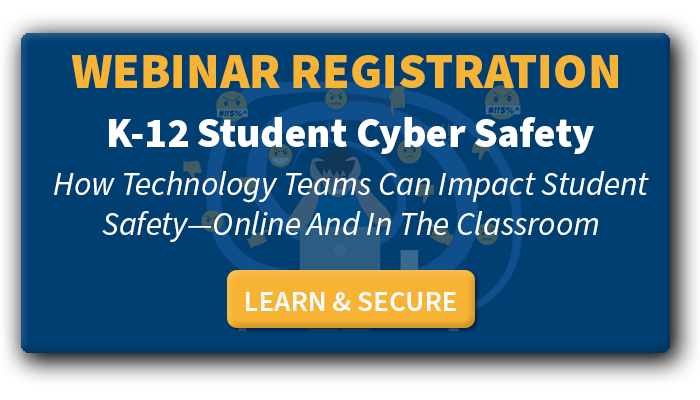Protect your students by using cyber safety technology to detect cyberbullies
There is a strong connection between cyberbullying and student cyber safety. Cyberbullying has wide-ranging effects on those being bullied. Impacts include psychological effects such as social anxiety, depression, eating disorders, and drug abuse. Students who are victims of cyberbullying are also at greater risk of becoming victims of other types of cyber attacks such as identity theft, sexual exploitation, and falling for scams.
Addressing the issues of cyberbullying and student cyber safety is necessary to keep your district’s students healthy—both mentally and physically—in an increasingly digital world. Many districts are turning to cyber safety monitoring tools and processes to help identify students who are in crisis and get them the help and resources they need.
What is Student Cyber Safety?
Cyber safety is the cautious and responsible use of personal information and online applications.
For students, that means that they need to be cautious about how they share their personal information and how they act online. Unfortunately, students don’t always think about cyber safety. This is especially true if a student is the victim of cyberbullying, when the emotional problems that are created can make them less careful of people reaching out to them online pretending to be their friend.
Student cyber safety encompasses both a student’s wellbeing and their data security. For example, if a student has their identity stolen, it can cause significant physical, financial, and psychological harm. Students need to be protected against the following types of risks while online:
- Sharing their personal information with cyberbullies or others who will take advantage of them
- Clicking on links that could damage their device or redirect them to inappropriate content
- Talking to cyber predators who set up bogus profiles to fool a student into thinking they’re talking to a peer, friend, or schoolmate
- Leaving themselves open to cyberbullying by engaging with the bully
- Becoming the victim of a scam because they don’t question the “special offer” they’ve received
- Posting something that will hurt them as adults
Cyberbullying and Cybersecurity
Cyberbullying and cybersecurity are related in K-12 schools and the online learning systems they use.
Students are using technology inappropriately every day. For example, IT admins have seen students use Google Docs as chat rooms, give Google Meet links to people outside of the school, and upload explicit images to Google Drive.
Cyberbullies hijack their victim’s account or create fake profiles in their victim’s name and do things to embarrass that student. Or, they create fake profiles to make friends with their victim. After they have a relationship established, the bully can lead their victim into doing things such as posting explicit photos of themselves or providing personal information that the bully can exploit.
Cyberbullies are even honing their skills to hack into the victim’s accounts. Once they have access, they can wreak havoc on the victim’s life. In fact, hackers often act as cyberbullies and create frightening situations.
For example, the problems with sextortion are increasing. A hacker contacts a student and gets close to them online. Then, when the vulnerable student is convinced the hacker loves them, the hacker pressures the student into sharing sexually explicit photos. The hacker can then use those images to bully or blackmail the student into offering payment or additional sexual favors to keep the images out of circulation.
Hackers as cyberbullies have also been known to obtain information from students that let the bully identify ways to contact their parents. The hackers message the parents with threats to physically harm them or their children unless a variety of demands are met.
Bullying used to be a boy calling a girl “fatty.” Today, cyberbullying is also a reason for districts to pay close attention to cybersecurity.
Student Cyber Safety, Mental Health, and Wellness
Addressing cyberbullying and student cyber safety ultimately comes down to protecting the physical and mental wellbeing of your students. Students don’t always follow good cyber safety measures, so it’s up to the schools to help keep them safe.
If students are victims of cyberbullying, the effects can be devastating. Victims of cyberbullying are more likely to:
- Struggle academically
- Develop social anxiety, which often causes sufferers to avoid all contact with others
- Engage in self-harm activities or consider suicide
- Engage in risky behaviors such as using drugs and alcohol
District IT teams can help with cyberbullying monitoring and the use of self-harm monitoring technology along with other student cyber safety solutions.
To get more information about K-12 cyber safety, you can watch our on-demand webinar recording. It will show you how you can use cyber safety artificial intelligence (AI) technology from ManagedMethods to monitor safety signals. You’ll also hear from Michael LeBlanc, Director of Information Technology at St. John’s School, as he describes his experience in using ManagedMethods Signals to help protect his students.

![[FREE WEBINAR] Student Cyber Safety in Schools. REGISTER HERE >>](https://no-cache.hubspot.com/cta/default/6834707/5cd0a157-352c-458b-9676-0ad9bb75645a.png)
